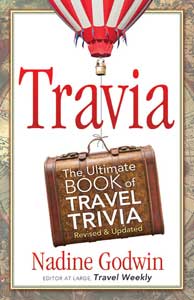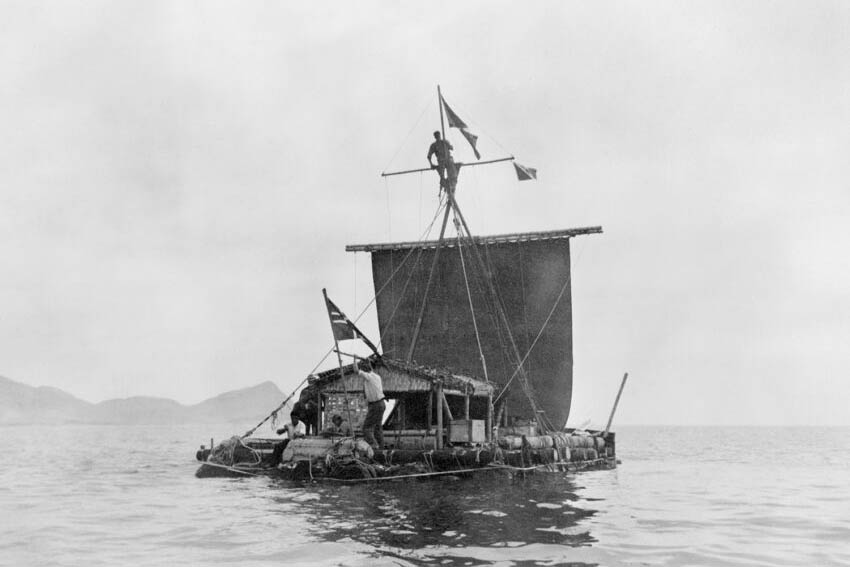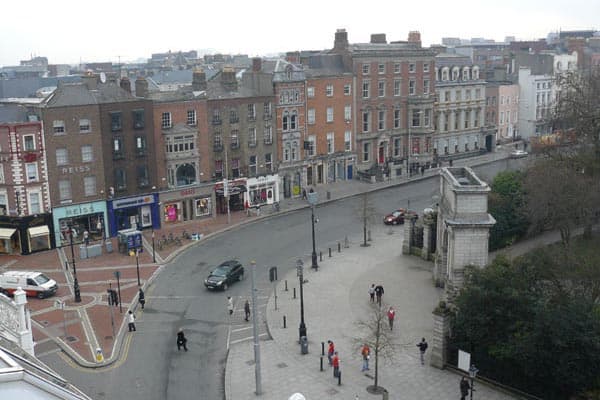
By Nadine Godwin
A cat flew nonstop across the Atlantic Ocean twice before Charles Lindbergh made his historic trip. The Eiffel Tower was nearly knocked down in the early 20th century. Guests cross the Equator to get from the lobby to the restaurant at the Mount Kenya Safari Club.
New Orleans was destroyed twice by hurricanes in the first three years after its founding in 1718. Panama hats come from Ecuador.
These and a broad range of other “trivial” factoids drawn from the world of travel are packaged into the 243-page paperback book, “Travia: The Ultimate Book of Travel Trivia,” written by Nadine Godwin, who is an editor at large for the travel trade newspaper Travel Weekly.
The book, with 663 items loaded with information readers never thought to ask for and (mostly) don’t really need, reflects the author’s lifelong interest in the (often) useless information.
Travel Trivia Selections
Until the mid- or late 1930s, many life insurance policies carried a rider saying coverage did not apply while the insured was on an airplane. Then, the more reliable DC-3 entered service in 1936; a year later, for the first time, passengers could buy flight insurance at the airport, at 25 cents for a $5,000 policy.
Ships are typically dedicated only by women (their “godmothers”) because of a superstition holding that the first person to touch a ship when she is coming into life should be a female, much as in the past the first person to touch a newborn human was a midwife (also a female). The French, Greeks, and Japanese are the exception; they will use men as well as women to dedicate ships.
Bare Necessities Tour and Travel in Austin, Texas, in February 2005 operated what it describes as the world’s largest-ever nude cruise, on a Caribbean sailing at full capacity aboard the 2,124-passenger Carnival Cruise Lines ship, the Legend.
Detroit, Michigan, is the first city you will reach when driving north from Canada’s Windsor, Ontario.
There have been five United States in the world: The United States of America, United States of Brazil, United States of Colombia, United States of Indonesia, and United States of Venezuela. Today there is one.
Earth’s surface is 70.8 percent water and only 29.2 percent land.
Strasbourg Cathedral, the world’s tallest building for 200-plus years, did not earn that title until catastrophe had befallen other churches — or, at least, their steeples. Lincoln Cathedral in Lincoln, England, became the tallest structure in 1311 at 525 feet (160 meters), but its highest spire fell off in a 1548 storm. As a result, St. Olaf’s Church in Tallinn, Estonia (completed around 1500 at 522 feet [159 meters]), moved to No. 1. However, it was struck by lightning, probably in 1625, and burned to the ground. Either of these could have kept the Strasbourg and Cologne cathedrals off the world’s list of tallest buildings.
London-Sydney
London-Sydney air service in 1938 involved 35 stops en route, including nine hotel nights. Air fares included hotels, meals, and gratuities. Airline timetables also described these terms: Britain’s Imperial Airways and Australia’s Qantas Empire Airways advised passengers they could book seats with a 25 percent down payment, but seats would be guaranteed on full payment of the fare. Each passenger was entitled to 100 kilos for personal weight and baggage.
The average passenger weighing 75 kg could carry 25 kg in baggage, it said, whereas free baggage allowance decreased as personal weight increased. However, passengers weighing more than 85 kg (187 pounds) were allowed 15 kg (33 pounds) regardless of their stature.
The first person to go over Niagara Falls in a barrel was a woman, Anna Edson Taylor, a former school teacher from Bay City, Mich., who made the plunge on her 63rd birthday. That was in 1901. A poor widow, she was driven by poverty (not unruly students). She survived, but she did not accomplish her real goal — a financial windfall. Since then, another 15 have gone over the falls as a gimmick, and five died in their attempts.
In Budapest, Hungary’s capital, nearly 100 thermal springs feed 12 spa baths and several spa hotels with 19 million gallons of thermal water daily.
“Vacation,” a new word to English in the 14th century, came to us as the Middle English “vacacioun” from the Latin “vacatio,” meaning freedom or exemption, and ultimately from the verb form “vacatus.” “Vacate” also derived from vacatus. In other words, when we say we want a vacation, we are saying, “We’re going to vacate” or, “We’re outta here.”
It takes 1.5 million hyacinths plus thousands of narcissus and other flowers to create the floats for the Bollenstreek Flower Parade each April in Holland. The procession, which winds its way from Noordwijk to Haarlem, is the largest of the flower processions seen in Holland from April through September. In some flower parades, only dahlias are used to decorate floats. Clearly, they are not all about tulips.
Istanbul, Turkey, boasts the Tunnel, the world’s shortest subway. Traveling only 1,880 feet and built in 1875, it takes passengers up and down a hill, and it makes the one-and-a-half-minute trip every few minutes. The city has a modern subway system, too, launched in 2000.
The Houshi Ryokan in Awazu, Japan, built in 718, is the world’s oldest continuously operating hotel. In addition, its current owners are the 46th generation of the same family to own and operate the property.
.jpg)
When the Mount Washington Hotel (opened 1902 at Bretton Woods, N.H.) was under construction, its Italian construction crew varied the number of steps leading to the second floor by using 33 steps from the registration area but only 31 in the South Tower. The difference was intended to confuse ghosts.
It wasn’t merely the ancients who expected to share their room at the Inn with others. Fast forward to medieval Europe, and things don’t look any better: Travelers typically slept in flea-ridden, rat-infested public houses where they shared rooms and beds with strangers. Things were not much improved in 18th century America, either, where travelers (usually men) overnighted at roadside taverns, sharing rustic bedrooms and sometimes their beds.
Yap, part of the Western Caroline Islands southwest of Guam, has the world’s largest money. The traditional tender looks like a large millstone with a hole in the middle and can be as big as 12 feet in diameter. For portable currency, Yapese still use smaller stones and shells, but tourists can use American dollars, Japanese yen, traveler’s checks, and credit cards.
Travelpro Luggage was the originator of (and holds the patent for) the soft-sided, upright luggage that travelers can roll onto an aircraft. The creator of the rolling suitcases, and the founder of the Travelpro business in 1989, is a former Northwest pilot, Bob Plath, who started by devising a rolling bag for himself and then began making them for airline colleagues equally eager for an easier way to carry their things.
Excerpted from “Travia: The Ultimate Book of Travel Trivia” by Nadine Godwin © 2006. Used with permission from the author and AFS Press. All rights reserved. Find this book at www.traveltriviabook.com. The cost for a single copy is $16.95 plus $4 S/H, with discounts for multiple-book purchases.
For more information, contact the marketing manager, John Hawks 859.519.9919/info@traveltriviabook.com, or the author, Nadine Godwin (nadine@traveltriviabook.com).
Buy This Book From Amazon Travia: The Ultimate Book of Travel Trivia
- Montreal’s Breweries Await Your Thirst - May 7, 2024
- Mother’s Day Ideas - May 6, 2024
- Exploring Kenya’s Night Markets - May 3, 2024




